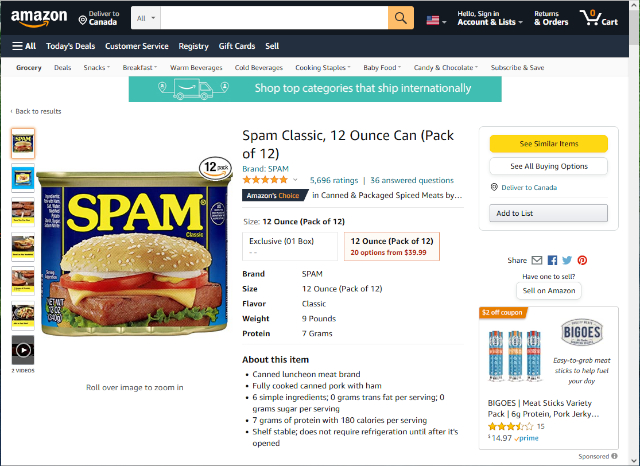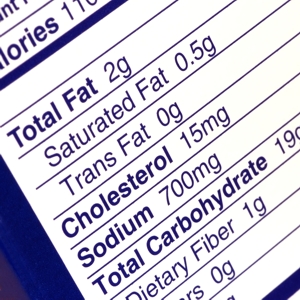Most developed countries have now mandated the posting of nutrition information on the labels of packaged and processed foods. I think we can all agree that’s a good thing, one that helps consumers compare products and decide what they want to serve their families…
 An Amazon Grocery Shopping: ‘Detailed product info’ page does
An Amazon Grocery Shopping: ‘Detailed product info’ page does
not include Nutrition Info, allergy info or links thereto…
But the rise of online grocery and specialty-food shopping has some observers concerned that the same nutrition info is not available for the vast majority of products being sold by virtual supermarkets and direct by manufacturers.
Kind of a ‘Catch 22’
Existing regulations in virtually all developed countries now mandate Nutriton Facts labelling on all packaged foods. And that’s become a fact of life for consumers. I for one would be shocked – well, at least curious – if I picked up an item off a supermarket shelf that didn’t have such labelling.
But the situation online is much different. In most cases, shoppers have to Google the nutrition Facts for products to access manufacturer info, or third party reference sites which basically reproduce the official Nutrition Facts labels from the products. I wonder how many shoppers actually take the time and make the effort to do that? Not a lot, I’ll bet.
A Wild West scenario
“Our study shows that the online food shopping environment today is a bit of a ‘Wild West’, with incomplete and inconsistent provision of required nutrition information to consumers,” says Dariush Mozaffarian, dean of the Friedman School and the senior author of a new study quantifying online nutrition labelling. “Online shopping will only continue to grow, and this creates an excellent opportunity to positively influence consumers to make healthy and safe choices. We need to leverage this chance to help make progress against the nutrition-related health crisis in this country.”
What they did
Researchers chose 10 major products and surveyed them across 9 major online grocery retailer sites to see what nutrition info was provided.
The target foods included bread, breakfast cereals and beverages – packaged foods that are required by the U.S. Food and Drug Administration (FDA) to display Nutrition Facts, a list of ingredients and allergy warnings, among other information.
What they found
“Information required to be provided to consumers in conventional grocery stores is not being uniformly provided online — in fact, it only appears on roughly a third of the online grocery items we surveyed,” says Dr. Jennifer Pomeranz, an assistant professor of public health policy and management at the NYU School of Global Public Health and lead author of the study,
According to an abstract of the report, the survey revealed that that this information was included and legible, on average, only 36.5 percent of the time across the products and retailers. Potential allergens were only disclosed on 11.4 percent of products, while nutrition facts and ingredients lists were each present only about half the time (45.7 percent and 54.2 percent, respectively). In contrast, marketing health and nutrition-related claims such as ‘low sodium’ on online product images were more common, appearing on 63.5 percent of products.
The takeaway
“Our findings highlight the current failure of both regulations and industry practice to provide a consistent environment in which online consumers can access information that is required in conventional stores,” says study co-author Sean Cash, the Bergstrom Foundation Professor in Global Nutrition at the Friedman School. “With the expectation that online grocery sales could top $100 billion for 2021, the requirements to provide consumers with information need to keep up with the evolving marketplace.”
“The federal government can and should act to require that online food retailers disclose required nutrition and allergen information to support consumer health and informed decision-making,” Pomeranz concludes.
My take
I have to come back to the point I stopped to make when discussing the ‘Catch 22’ nature of the issue. How important is it to require full Nutrition Facts, ingredients and allergy information in online listings for products if the majority of folks don’t use them?
A 2019 survey titled Nutrition Facts: who is using them, what are they using, and how does it relate to dietary intake? found that only about 1 in 3 women and 1 in 4 men refer to the Nutrition Facts listings on product packages while making their in-store purchasing decisions. I suspect that these user groups include those who must be aware of potential allergy issues, or want to make sure that foods don’t violate their religious or self-chosen dietary prohibitions. So the number of shoppers who choose to consult Nutrition Facts and ingredients labelling will actually be even lower than the 2019 survey results suggest. Furthermore, those who want or need the nutrition information will most likely do what I do as a matter of course: Google “nutrition facts” plus the product name.
So do we really have to mandate the display of Nutrition Facts and related info on online food product pages?
Muse on that…
~ Maggie J.

